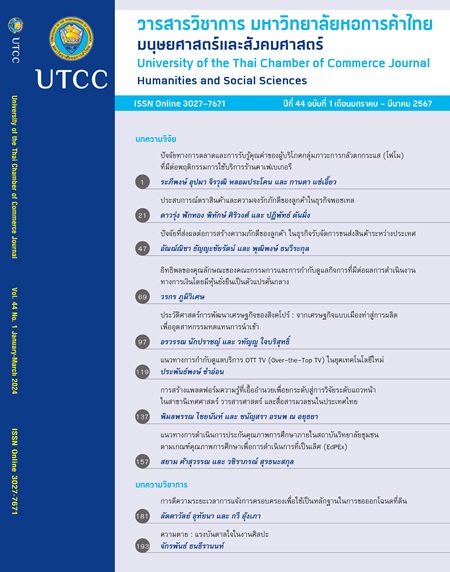History of Singapore's Economic Development: Transforming from Entrepôt Trade to Import Substitution Industrialization
Main Article Content
Abstract
This research aims to study Singapore's economic history and identify key factors driving its economic development between 1819 and 1965. Singapore served as an entrepot under the British Empire since 1819 and transformed itself to adopt the import substitution industrialization (ISI) policy in 1965. This qualitative research collects secondary data from literature and economic indicators from Singapore and other agencies’ databases. Data is further analyzed using the growth theory and Rostow's five-stage model. Key findings show after the establishment of trading posts by the British East India Company (EIC) in 1819, Singapore's economy rapidly thrived and grew. Such prosperity was driven by its strategic location, the free trade policy, the arrival of steamboats resulting from the Industrial Revolution, and the opening of the Suez Canal. However, after World War II, Singapore's economy suffered from sluggish growth, low wages, a high unemployment rate, and limited opportunities to expand its entrepôt trade. Singapore's economy was then diversified and restructured and its adoption of import-substituting industrialization policy between 1959 -1965 caused the revival of economic expansion, reduction of the unemployment rate, and increase of manufacturing proportion.
Article Details

This work is licensed under a Creative Commons Attribution-NonCommercial-NoDerivatives 4.0 International License.
ลิขสิทธิ์ของบทความ
ผลงานที่ได้รับการตีพิมพ์ถือเป็นลิขสิทธิ์ของมหาวิทยาลัยหอการค้าไทย ห้ามมิให้นำเนื้อหา ทัศนะ หรือข้อคิดเห็นใด ๆ ของผลงานไปทำซ้ำ ดัดแปลง หรือเผยแพร่ ไม่ว่าทั้งหมดหรือบางส่วนโดยไม่ได้รับอนุญาตเป็นลายลักษณ์อักษรจากมหาวิทยาลัยหอการค้าไทยก่อน
References
โคริน เฟื่องเกษม. (2542). การพัฒนาเศรษฐกิจและการเมืองสิงคโปร์. กรุงเทพฯ:มหาวิทยาลัยธรรมศาสตร์, สถาบันเอเชียตะวันออกศึกษา.
โคริน เฟื่องเกษม. (2554). สิงคโปร์ภายใต้สามผู้นำ. กรุงเทพฯ: โรงพิมพ์เดือนตุลา.
จาตุรนต์ อำไพ. (2555). ประวัติศาสตร์เศรษฐกิจเมืองเชียงคาน (การค้นคว้าอิสระปริญญามหาบัณฑิต ไม่ได้ตีพิมพ์). จุฬาลงกรณ์มหาวิทยาลัย, กรุงเทพฯ.
เชอะ, อี. ซี.ที., และ ลี, อี. (2557). ประวัติศาสตร์สิงคโปร์ (เพ็ชรี สุมิตร, ผู้แปล). กรุงเทพฯ: มูลนิธิโครงการตำราสังคมศาสตร์และมนุษยศาสตร์.
ณัฐวดี พรหมหิตาทร. (2558). ผลกระทบของอัตราการออมต่ออัตราการเจริญเติบโตทางเศรษฐกิจในประเทศไทย (การค้นคว้าอิสระปริญญามหาบัณฑิต, มหาวิทยาลัยเกษตรศาสตร์). สืบค้นจาก https://econ.eco.ku.ac.th/2016/is/IS%205713.pdf
เทิร์นบุลล์, ซี. เอ็ม. (2540). ประวัติศาสตร์มาเลเซีย สิงคโปร์และบรูไน (ทองสุก เกตุโรจน์, ผู้แปล). กรุงเทพฯ: กรมวิชาการ.
นิภาพร รัชตพัฒนากุล. (2558). ประวัติศาสตร์เศรษฐกิจและสิ่งแวดล้อมอ่าวบ้านดอน: กรณีศึกษา การเพาะเลี้ยงสัตว์น้ำชายฝั่งระหว่างทศวรรษ 2490 ถึงทศวรรษ 2540. กรุงเทพฯ: สำนักงานคณะกรรมการส่งเสริมวิทยาศาสตร์ วิจัย และนวัตกรรม.
บังอร ปิยะพันธุ์. (2537). ประวัติศาสตร์เอเชียตะวันออกเฉียงใต้. กรุงเทพฯ: โอเดียนสโตร์.
Fact sheet สิงคโปร์ สิงหาคม 2566. (2566). สืบค้นเมื่อ 2 ตุลาคม 2566, จาก https://www.ditp.go.th/post/146789
ภูวดล ทรงประเสริฐ. (2547). จีนโพ้นทะเลสมัยใหม่. กรุงเทพฯ: แบรนด์เอจ.
ไรอัน, เอน. เจ. (2526). การสร้างชาติมาเลเซียและสิงคโปร์ (ม.ร.ว.ประกายทอง สิริสุข, ผู้แปล). กรุงเทพฯ: ไทยวัฒนาพานิช.
วิภารัตน์ ปั้นเปี่ยมรัษฎ์, สุวิทย์ สรรพวิทยศิริ, ยุทธภูมิ จารุเศร์นี, ศศิน พริ้งพงษ์, จงกล คำไล้, และพิมพ์นารา หิรัญกสิ. (2554). การพัฒนาระบบการวิเคราะห์ศักยภาพการผลิตของประเทศไทยโดยใช้นโยบายการคลัง. กรุงเทพฯ: สำนักงานเศรษฐกิจการคลัง.
สมส่วน ฮาว (2558). รายงานการศึกษาส่วนบุคคลเรื่อง ศักยภาพของไทยด้านความร่วมมือเพื่อการพัฒนาภายใต้เป้าหมายการพัฒนาที่ยั่งยืน. กรุงเทพฯ: กระทรวงการต่างประเทศ, สถาบันการต่างประเทศเทวะวงศ์วโรปการ. สืบค้นจาก https://image.mfa.go.th/mfa/0/yZ0EO327fd/nbt/nbt7/IS/7008.pdf
อนุชา ภูริพันธุ์ภิญโญ. (2556). แนวคิดการพัฒนาเศรษฐกิจ. ใน ประมวลสาระชุดวิชาสังคมไทยกับการบริหารการส่งเสริมและพัฒนาการเกษตร: หน่วยที่ 4 (น. 4-1 – 4-87). นนทบุรี: มหาวิทยาลัยสุโขทัยธรรมาธิราช.
Aiyer, S. (2006). From colonial segregation to postcolonial integration - Constructing ethnic difference through Singapore's Little India and the Singapore Indian (Doctoral dissertation, University of Canterbury). Retrieved from https://core.ac.uk/reader/35461221
Allen, R. C. (2013). American exceptionalism as a problem in global history. Journal of Economic History, 71, 901-927.
Choy, K. M., & Sugimoto, I. (2013). Trade, the staple theory of growth, and fluctuations in colonial Singapore, 1900-39. Australian Economic History Review, 53(2), 121-145. doi:10.1111/aehr.12007
Entrepot trade of Singapore. (1945). Singapore: Department of Trade and Industry.
Huff, W. G. (1987). Patterns in the economic development of Singapore. The Journal of Developing Areas, 21(3), 305-326.
Ken, W. L. (1978). Singapore: Its growth as an entrepot port, 1819-1941. Journal of Southeast Asian Studies, 9(1), 50-84.
Kim, S. P. (1985). Government and politics of Singapore. In J. S. T. Quah, C. H. Chee, & S. C. Meow (Eds.), Government and politics of Singapore (pp. 3-24). Singapore: Oxford University Press.
Library of Congress. (1991). Singapore: A country study. Retrieved from https://tile.loc.gov/storageservices/master/frd/frdcstdy/si/singaporecountry00lepo/singaporecountry00lepo.pdf
Margolin, J.-L. (2010). The people's action party blueprint for Singapore 1959-1965. In K. Hack, J.-L. Margolin, & K. Delaye (Eds.), Singapore from Temasek to the 21st century: Reinventing the global city (pp. 292-322). Singapore: National University of Singapore.
Muller, A. (1997). The government in the economic history of Singapore. South African Journal of Economic History, 12(1-2), 54-76. doi:10.1080/10113439709511095
Petsas, I. (2003). Chapter 10: Trade policy in developing countries. Retrieved February 2, 2021, from http://www.eco.uc3m.es/docencia/EconomiaMundial/materiales/Trade_Policy_ch10.pdf
Reid, A. (2010). Singapore between cosmopolis and nation. In K. Hack, J.-L. Margolin, & K. Delaye (Eds.), Singapore from Temasek to the 21st century: Reinventing the global city (pp. 37-54). Singapore: National University of Singapore.
Romer, P. M. (1986). Increasing returns and long-run growth. Journal of Political Economy, 94(5) 1002-1037.
Schelander, B., & Hsu, A. (1998). Singapore: A history of the lion city. Honolulu, HI: University of Hawaii at Manoa, Asian and Pacific Studies, School of Hawaiian, Center for Southeast Asian Studies.
Temin P. (2014). Economic history and economic development: New economic history in retrospect and prospect. Retrieved from https://www.nber.org/system/files/working_papers/w20107/w20107.pdf
Trocki, C. A. (2006). Singapore: Wealth, power and the culture of control. London, England: Routledge.
Van Elkan, R. (1995). Singapore’s development strategy. In K. Bercuson (Ed.), Singapore: A case study in rapid development (pp. 11-19). Washington, DC: International Monetary Fund.
Voitländer, N., & Voth, H.-J. (2013). How the west ‘invented’ fertility restriction. American Economic Review, 103(6), 2227-2264.
World Bank. (n.d.). World Bank open data: Singapore. Retrieved December 2, 2023, from https://data.worldbank.org/country/singapore


